这个zero()是 julia 中的一个内置函数,用于返回 x 类型的附加标识元素,其中 x 也可能是类型本身。
用法: zero(x)
参数:
- x:指定值。
返回值:它返回 x 类型的附加标识元素,其中 x 也可能是类型本身。
范例1:
# Julia program to illustrate
# the use of zero() method
# Getting the additive identity element
# for the type of given parameter
println(zero(0))
println(zero(1))
println(zero(5.6))
println(zero(big"2.0"))输出:
范例2:
# Julia program to illustrate
# the use of zero() method
# Getting the additive identity element
# for the type of given parameter
println(zero(rand(1, 1)))
println(zero(rand(2, 2)))
println(zero(rand(3, 3)))输出:
[0.0] [0.0 0.0; 0.0 0.0] [0.0 0.0 0.0; 0.0 0.0 0.0; 0.0 0.0 0.0]
相关用法
- Julia one()用法及代码示例
- Julia findmin()用法及代码示例
- Julia first()用法及代码示例
- Julia last()用法及代码示例
- Julia ceil()用法及代码示例
- Julia floor()用法及代码示例
- Julia min()用法及代码示例
- Julia axes()用法及代码示例
- Julia parent()用法及代码示例
- Julia typeof()用法及代码示例
- Julia collect()用法及代码示例
- Julia pairs()用法及代码示例
- Julia conj()用法及代码示例
- Julia max()用法及代码示例
- Julia trunc()用法及代码示例
- Julia abs()用法及代码示例
注:本文由纯净天空筛选整理自Kanchan_Ray大神的英文原创作品 Getting additive identity element in Julia – zero() Method。非经特殊声明,原始代码版权归原作者所有,本译文未经允许或授权,请勿转载或复制。
